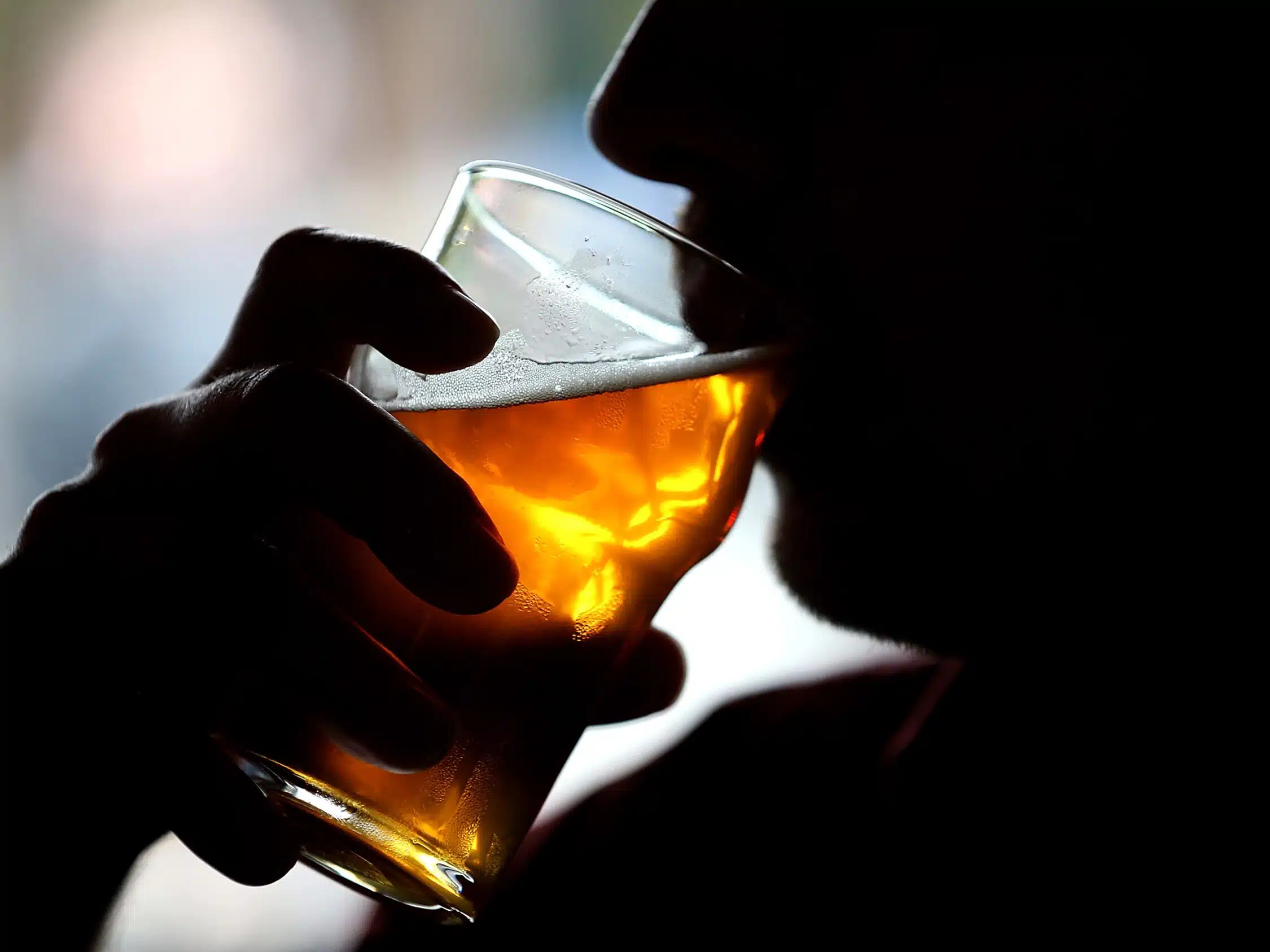
There are several troublesome effects for human physiology that come from consuming alcohol. The greater the amount of alcohol consumed, the faster it is consumed, and the more frequently it is consumed all affect the total impact negative impact alcohol has.
In this article, we’ll look closer at the basics of drinking, and how to know when alcohol consumption is at a point where adverse health effects, including addiction, are likely to come into play.
What counts as a drink?
In the United States, the standard drink is defined as any beverage containing 14 grams, or around .6 fluid ounces, of pure ethanol, regardless of the total ounces of the drink.
A 12 ounce beer, a 5 ounce glass of wine, and a shot of 1.5 ounces of hard liquor each count as one drink. Beer usually has around a 5% alcohol level, wine around a 12% alcohol level, and spirits a 40% alcohol level, hence the different overall volumes.
Within each of these types of alcoholic beverages, there are variations, with some versions having higher concentrations of alcohol. Some craft beers, for example, are more like 8 or 9% alcohol. The average bottle of wine, at 12% alcohol, is five drinks, but when the alcohol concentration is higher, as in some wines, the number of drinks counted is higher. Many cocktails include more than one drink’s worth of alcohol.
How many drinks are in common containers?
Alcoholic beverages are packaged in standardized ways, so you can calculate how many drinks are included in a given container.
Regular beer, with a concentration of 5% alcohol by volume, is served in containers of 12 fluid ounces (1 drink), 16 fluid ounces (1.3 drinks), 22 fluid ounces (2 drinks), and 40 fluid ounces (3.3 drinks). Malt liquor, with a higher concentration of 7% alcohol, is packaged in containers of 12 ounces (1.5 drinks), 16 fluid ounces (2 drinks), 22 fluid ounces (2.5 drinks), and 40ounces (4.5 drinks).
Table wine, usually 12% alcohol, comes in containers of 750 ml (5 drinks).
80-proof distilled spirits, 40% alcohol, come in single shot containers (1 drink), in mixed drinks (1 or more drinks), in a 200ml half pint bottle (4.5 drinks), in 375ml pint bottles (8.5 drinks), 750 ml “fifth” bottles (17 drinks), and 1.5 L “magnum” bottles (34 drinks).
When is having any alcohol too much?
There are several situations in which people should avoid alcohol altogether. Here are some of the most common reasons to decide not to drink at all:
- Medications
Many common medications cannot be safely consumed together with alcohol. Some are made ineffective, and many have disastrous effects when taken in combination with alcohol. It is very important to pay attention to this factor when using prescriptions for any purpose.
- Pregnancy
Women who are trying to get pregnant, and women who are pregnant, should avoid drinking, for their own health implications as well as that of the potential baby’s.
- Medical conditions affected by drinking
Many medical conditions are made much worse by drinking, such as diabetes and liver disease. This includes mental health diagnoses, such as bipolar disorder, depression, and anxiety. Chronic pain is also adversely affected by drinking.
- Underage
People who have not yet matured to adulthood are significantly more impacted by the damaging effects of alcohol and other drugs. People under the age of 21 are vulnerable to changing their body’s basic functioning permanently if they drink alcohol, especially to excess, but even at moderate levels.
- Facial Flushing and Dizziness when Drinking
Around a third of people with East Asian heritage possess a genetic enzyme deficiency which makes alcohol unsafe for them. Symptoms of flushing and dizziness indicate the presence of this condition, which increases risk for alcohol related cancers like head and neck cancer, even with only light use of alcohol.
- People who are planning to drive a vehicle or operate machinery
It is not safe to combine any amount of alcohol with driving or using equipment.
What are the U.S. Dietary Guidelines on alcohol consumption?
The US Dietary Guidelines (https://www.dietaryguidelines.gov/resources/2020-2025-dietary-guidelines-online-materials) state that for adult women who choose to drink alcohol, it is recommended that they have maximum one drink per day.
The one drink a day guideline for women is not meant as an average, but as a daily limit. Drinking beyond this amount brings blood alcohol levels into range where there are physiological consequences of a negative nature.
The notion that light to moderate drinking is healthy is prevalent. However, more recent research has cast doubt on this common dictum. Past studies may have confused the impacts of light to moderate drinking with co-existing factors like healthy diet and other behavioral differences. More recent studies show evidence than even light to moderate drinking increases risk factors for several serious conditions, such as cancer and heart disease.
The updated picture of the impacts of alcohol use is as follows: people who do not drink at all have several health advantages over those that do, in terms of less risk of cancer and other diseases. Among people who do drink, the less alcohol a person consumes, the better it is for their long term health and longevity.
What is heavy drinking?
Heavy drinking is a term that encompasses binge drinking, and it refers to women drinking four or more drinks on any given day, and/or eight or more drinks in one week. Binge drinking is defined as drinking enough alcohol to bring the average woman’s blood alcohol concentration to .08% or higher, which for most women would take consuming four drinks within two hours.
Heavy drinking thresholds are lower in women than in men, because of the ways that alcohol is diluted in the body’s water levels. A woman drinking the same amount of alcohol as a man will have a higher blood alcohol concentration. That means that when women drink the same amount of alcohol as men, the health impacts are greater.
There are two types of dangers that come from excessive alcohol, one is the “too much too fast” variety, and the other is the “too much, too often” variety.
The “too much, too fast” variant refers to what happens when women binge drink. When a woman has four or more drinks within a space of two hours, her blood alcohol concentration will reach .08%, or the definition of binge drinking.
Binge drinking is responsible for more than half of the deaths caused by alcohol. Binge drinking increases the risk of harm through multiple avenues, including car crashes, falls, burns, memory loss, blackouts, medication interactions, sexual and physical assault, overdose deaths, and drowning.
In the “too much, too often” category, women who frequently drink to excess are at risk of longer term consequences as well as the above category of immediate consequences. Longer term consequences include developing an alcohol use disorder (AUD), liver damage, cancer, heart disease, and brain damage.
What is the clinical utility of the “heavy drinking day” metric?
The definition of a heavy drinking day is a helpful measure for motivating change. Knowing that heavy drinking days carry a risk of death (immediately through accidents, or in the longer run through cancer or heart disease) can help encourage women to reduce their drinking until it falls within the range wherein fewer consequences will be experienced.
It is also beneficial to think about typical weekly volume, because the more frequently a woman has heavy drinking days, and the greater the overall volume she consumes, the more likely she is to develop addiction to alcohol.
Becoming addicted to a substance is an important negative turning point which is best avoided, if possible, through reducing or stopping use before developing this condition. Although addiction can be treated, it is very difficult to reverse entirely. Once a certain line has been crossed, a woman can never go back to her pre-drinking self.
The Basics of How the Body Processes Alcohol
Absorption into the Bloodstream
When a woman drinks alcohol, it goes first into her stomach and intestines. After that, it is released into her bloodstream. Once in her blood, alcohol distributes itself evenly over all of the body’s water, throughout all tissues and bodily fluids.
The more alcohol she drinks over a given period of time, the higher the concentration of alcohol in the blood and other bodily fluids. Alcohol is absorbed into the bloodstream more rapidly than the body can metabolize it, increasing blood alcohol concentration levels as more drinks are consumed.
Metabolism
The body begins the process of metabolizing alcohol moments after ingestion. Metabolism proceeds at a stable rate, regardless of how many drinks are consumed additionally, and independent of the addition of other substances like caffeine.
An enzyme in the liver, alcohol dehydrogenase, works to turn ethanol into the toxic compound acetaldehyde, which is carcinogenic. The body works quickly to break the toxic acetaldehyde down further into a less toxic compound, acetate, by way of aldehyde dehydrogenase. Acetate is processed further in tissues outside the liver, into water and carbon dioxide, which can be eliminated by the body using natural channels.
Although each person’s metabolism operates at a steady rate, that rate of metabolism varies by person depending on individual factors, including body mass, genetics, and liver size.
Villa Kali Ma offers holistic alcohol addiction treatment for women
Women are especially vulnerable to the many forms of potential harm that accompany alcohol abuse. Safety is compromised in many ways when women drink to excess, including through sexual assault, violence, and other deeply traumatizing events. In the longer term, women’s health suffers severely when alcohol-related cancers and heart disease patterning take root in the body. Finally, the psychological nightmare of addiction gradually becomes a certainty, the longer a woman drinks too much.
The tragedy of the matter is that the real reasons women binge drink have very little to do with a desire to die or experience even more danger than they already have; on the contrary, drinking is a search for peace, safety, and wellbeing.
Whatever your story is, if you’re interested in how women can stop drinking, you may be interested in Villa Kali Ma’s many programs for helping women heal through holistic pathways. We address substance use disorders, as well as the underlying emotional and trauma needs that women have, through evidence-based clinical practices combined with natural healing modalities like Ayurveda, yoga, and meditation.

